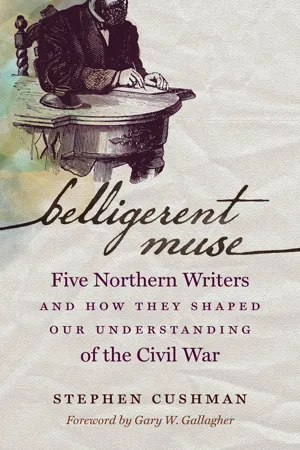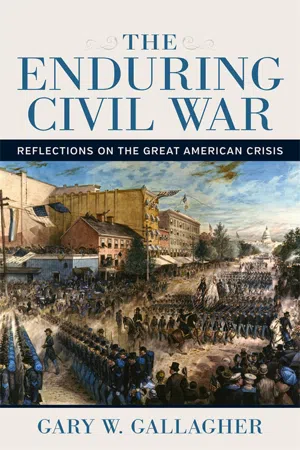History
General Sherman
General William Tecumseh Sherman was a prominent Union general during the American Civil War. He is best known for his "March to the Sea," a military campaign that involved devastating the Confederate heartland by destroying infrastructure and resources. This strategy, known as total war, aimed to break the South's will to fight and played a significant role in the Union's victory.
Written by Perlego with AI-assistance
Related key terms
Related key terms
1 of 4
Related key terms
1 of 3
10 Key excerpts on "General Sherman"
- eBook - ePub
On War and Leadership
The Words of Combat Commanders from Frederick the Great to Norman Schwarzkopf
- Michael Owen Connelly(Author)
- 2009(Publication Date)
- Princeton University Press(Publisher)
II William Tecumseh Sherman (1820–1891) UNION GENERALS William T. Sherman and Ulysses S. Grant set patterns for the mass warfare of the twentieth century. Moreover, their campaigns, combining the destruction of the enemy homeland and mass assault into it, are still at the heart of what Weigley calls “the American Way of War.” 1 In 1864–65,Sherman burned Atlanta and marched to the sea at Savannah, then north through the Carolinas, destroying the material base of the Southern armies and the morale of Southern troops and civilians. Grant, in the East, and Sherman in the West and South, forced the Rebels to build fortifications and use trenches and barbed wire to offset Yankee numbers and firepower. Union troops, in turn, took to trenches as well. Grant and Sherman left a legacy of trench warfare. That, conscription, and the Prussian general staff system 2 would all be used by both sides in the Great War (1914–18), and account for its horrors. Sherman especially, assailing the South with masses of men and superior weapons, did what bombing and the Soviet and Western invasions of Germany would do for the Allies in World War II—and for the United States in lesser wars since. Sherman is included here because he was the more intellectual of the leading Northern commanders, and had more to say about generalship in his Memoirs (cited below). He is remembered for his “War is Hell,” which he meant in all senses. But for him, although it is rarely mentioned, it was Hell because his heart was with the South, while his head was against destroying the Union. His devastation of the South was meant to end the war quickly—and did - LTC James M. Diamond US Army(Author)
- 2015(Publication Date)
- Golden Springs Publishing(Publisher)
William Tecumseh Sherman: Growth of a Strategist
In the opening days of the American Civil War strategic thought, in the minds of many who would lead the North’s forces, could be summed up in the three stirring words “On to Richmond!”One who saw beyond that enticing but ultimately false course was William Tecumseh Sherman. How was it that Sherman, who had left the Army in 1853 and was serving as the President of the Louisiana Seminary of Learning and Military Academy as the war approached, was able to see what the senior military and political leaders of the North could not?The way Sherman perceived the coming struggle, what he thought about the ends, means, and ways with which he would labor for those four bloody, terrible years was in part based on his unique personality and in part developed over years of study, travel, and experience. Those thoughts and experiences, distilled by Sherman’s quick, trenchant intellect ultimately produced a strategic vision of ways and means to achieve the military and political ends of the Union in the Civil War.Sherman’s successful collaboration with his contemporary and commander, U. S. Grant, brought the Union victories in the field and eventually victory in the war. Sherman’s contributions to their efforts took many forms. He was a superb subordinate to Grant, aggressive in the field, quick in carrying out his orders and in accomplishing his missions. He was also able, perhaps to a greater degree than Grant, to see and understand things about this war that often escaped others.Despite his ultimate success Sherman did not appear on the field with all of the answers and all of the authority he needed to defeat the South. Indeed, he spent the first two years of the war growing, sometimes through very painful lessons, to reach his potential as a commander and strategist. But these first two years of the war were only a continuation of a lifetime of trials, growth, observation, study, and occasional failure that finally produced the Army Commander who would contribute so much to the Union victory’ in the Civil War.- eBook - ePub
- Ethan S. Rafuse, Ethan S. Rafuse(Authors)
- 2017(Publication Date)
- Routledge(Publisher)
21In later orders to subordinates Sherman and Sheridan, Grant would demonstrate his commitment to even harsher forms of warfare. Sherman was to "get into the interior of the enemy's country as far as you can, inflicting all the damage you can upon their war resources."22 And prior to unleashing Sheridan's juggernaut upon the Shenandoah Valley in 1864, Grant declared, "If the war is to last another year, we want the Shenandoah Valley to remain a barren waste."23If the blast furnace of war produced a Grant cleansed of restraint, it also kindled the righteous fury of William Tecumseh Sherman, whose name would become synonymous with destruction throughout the South. His famous March to the Sea and the March though the Carolinas have become infamous through tales of wanton and complete destruction. These legends have much basis in fact, though ironically Sherman began the Civil War convinced of the need for law and order. His transformation in 1862 was similar to Grant's, as he explained to a friend in 1864.I would not let our men burn fence rails for fire or gather fruit or vegetables though hungry. . . . We at that time were restrained, tied by a deep-seated reverence for law and property. The rebels first introduced terror as part of their system. . . . Buell had to move at a snail's pace with his vast wagon trains . . . Bragg moved rapidly, living on the country. No military mind could endure this long, and we were forced in self-defense to imitate their example.24Sherman thus argued that the switch to more brutal warfare came out of military necessity; defeating the South required imitating their tactics. Coupled with Grant's focus on guerrillas, which Sherman soon came to share, these ideas were rooted in the belief that Southern forces brought war and vengeance upon themselves. This became a theme throughout Sherman's writings, and it echoed a belief shared by much of the Union Army. He wrote: - eBook - ePub
- Samuel Willard Crompton(Author)
- 2014(Publication Date)
- Visible Ink Press(Publisher)
In telegraphs to the War Department, Sherman spoke of the need to cut loose from his base, meaning Atlanta. General Hood was leading what remained of the Army of Tennessee into the state of that name, threatening to cut the railroad and telegraph lines. Sherman could, of course, pursue Hood, but to do this meant giving up the 150 miles of turf he and his men had fought so hard to win. Much better, Sherman declared, to ignore Hood and strike out for the Atlantic coast.In his “march to the sea,” General Sherman burned everything in his wake to assure the Confederates could not use the land after Union troops had passed through. The “scorched earth” tactic was quite controversial for the harm it did to average Southern citizens.Doing so would remove Sherman from communications as well as supplies, but he was confident his hard-bitten veterans could live off the land and that in doing so they would “make Georgia howl.” Given that Georgia had over one million inhabitants, the 70,000 men of Sherman’s army would not suffer, he declared; instead, they would take what they needed, leaving the rebels to suffer during the winter.Did anyone in Washington, D.C., claim that this was too harsh?
Almost no one. From Lincoln down to Stanton and Grant, the concern revolved around whether Sherman and his men would find enough to eat on their march: little, if any, concern was demonstrated for the plight of the civilians in their path. Grant had some doubts about the whole venture from a military point of view, but he finally gave the go-ahead on October 11, 1864, telegraphing Sherman that “If you are satisfied the trip to the sea-coast can be made, holding the line of the Tennessee river firmly, you may make it.”To hold the Tennessee River, Sherman had already dispatched Major-General George Thomas with 20,000 men north to Chattanooga. These and the reinforcements that would come from the North were sufficient to hold Hood at bay, he declared, and he meanwhile would march through the South.What, meanwhile, had Sheridan accomplished in the Shenandoah Valley?
General Philip Sheridan (1831–1888) was only thirty-three, but his recent successes, especially his attack on J. E. B. Stuart in May 1864, had brought him to the forefront where cavalry actions were concerned. Hot-tempered and impulsive, Sheridan was a born fighter, and, according to some observers, the only Union leader whose very physical presence seemed to expand on the battlefield: he looked taller and larger during combat. Some of this sounds like hyperbole to our modern ears, but it is how Sheridan seemed to his contemporaries. - eBook - ePub
Civil War America
Controversy and Conflict over the American Civil War
- Joan Waugh, Gary W. Gallagher, Joan Waugh, Gary W. Gallagher(Authors)
- 2009(Publication Date)
- The University of North Carolina Press(Publisher)
William T. Sherman in Postwar Georgia’s Collective Memory, 1864-1914 CAROL REARDONIn February 1891, shortly after the death of William Tecumseh Sherman, a Georgia journalist posited an intriguing question: “How shall we judge a man who was one day all fire, and the next day all ice: forgiving one moment, and relentless the next, a patriot today and a partisan tomorrow?”1 This query suggests that, after the passage of nearly thirty years, Georgians’ collective memory of the famed Union general could provoke surprisingly reflective consideration. Indeed, by the time of the Civil War’s golden anniversary, Sherman’s place in Georgia’s past did not rest solely on bitter recollections of the military events of 1864. Through the years, the political and social crises of Reconstruction, the blossoming of both the Lost Cause and the New South mentalities, and the rise of Jim Crow had spawned a surprising diversity in the ways in which Georgians remembered him.From the time the Union army launched its offensive from Chattanooga in May 1864 until it marched into South Carolina in January 1865, many Georgians experienced sociologist Arthur G. Neal’s three “ingredients” of trauma: “some form of bafflement, some level of suffering, and perceptions of evil in human affairs.”2 Thousands in the direct path of the Union army experienced the near-total collapse of the familiar rhythms of their daily lives, confronting confusion, insecurity, and loss first as individuals and families and then as citizens of a larger political entity. To make sense of the chaos breaking around them, Georgians demanded to know what happened and, even more importantly, why it had happened.During the 1864 campaign, few Georgians truly comprehended what had happened to their state. Newspapers and the telegraph system brought only incomplete and contradictory assessments of fast-breaking events that might provide context for an individual’s or family’s own experiences—or contradict them entirely. In a single issue of a Georgia newspaper during Sherman’s March to the Sea, for instance, readers could find detailed, block-by-block lists of destroyed buildings in Atlanta and, a few columns away, find confident boasts that loyal citizens most certainly would take up arms to defeat Sherman before he could ever wreak any such havoc. Reports of outrages against women and children attributed to Sherman’s “bummers” appeared in the same issue as stories of unexpected benevolence extended by the northern invaders. Georgians read of faithful slaves saving their masters’ lives and property and of other slaves willingly pointing out to Yankee soldiers the caches of food and valuables their masters had hidden.3 - eBook - ePub
Demon of the Lost Cause
Sherman and Civil War History
- Wesley Moody(Author)
- 2011(Publication Date)
- University of Missouri(Publisher)
Historically, the type of behavior Sherman's army is accused of would rally an enemy's troops to fight harder. The Confederate government and its allies in the major newspapers of the South obviously believed this, as they published numerous propaganda stories about Sherman and other callous Union generals in order to motivate Confederate soldiers. Before Sherman had even accepted a position in the Union army, Jefferson Davis predicted that the North would behave that way in order to engender support for the Confederate cause. 33 Sherman's army destroyed a great deal of railroad during his campaigns, but so did every other general during the war. It was by no means a strategy invented by Sherman, nor was the destruction of railroad necessarily an attack on the enemy's economy. Armies were moved by railroad, reinforcements and supplies brought up and positions evacuated. The Union was defeated at Chickamauga because Longstreet had brought a large force from the east by railroad. Sherman was a veteran of the army that had been defeated at Bull Run because General Johnston had reinforced General Beauregard by train. 34 Attacking a railroad was the equivalent of attacking an enemy's baggage train or of the British navy's attacking empty troop transport ships during the Napoleonic Wars. Economic warfare also by no means originated with Sherman or the American Civil War. The most obvious example of this is a naval blockade. Both France and Britain blockaded one another during the Napoleonic Wars in order to hurt the economies of their foes and to make it more difficult for the enemy to supply his army. 35 Hart has affected Sherman's reputation more than any other historian. His theories have been used and misused by historians ever since - Lieutenant-General John Schofield(Author)
- 2015(Publication Date)
- Golden Springs Publishing(Publisher)
In connection with Sherman’s operations it is essential to bear in mind the distinction between two radically different kinds of strategy, one of which has for its object the conquest of territory or the capture of places by defeating in battle or out-manoeuvering the defending armies; while the other has for its object the destruction or capture of those armies, resulting, of course, in the conquest of all the enemy’s territory. The first kind may be all-sufficient, and hence best, in a foreign war having for its object anything less than total conquest; but in the suppression of a rebellion, as in a foreign conquest, the occupation of places or territory ought to be entirely ignored except so far as this contributes to the successful operation of armies against opposing forces. This fundamental principle appears to have been duly appreciated by the leading Union commanders near the close of the Civil War, though not so fully in its earlier stages. Military critics are apt to fall into error by not understanding the principle itself, or by overlooking the change of policy above referred to.SHERMAN’S PURPOSE IN MARCHING TO THE SEAIt is necessary not to confound the “march to the sea” as actually conceived and executed by Sherman as a preliminary to the march northward for the capture of Lee’s army, with the previous far-reaching strategic plans of Grant, of which Sherman and other chief commanders were informed in the spring of 1864.Grant’s plans had in view, as their great object, again to cut in two the Confederate territory, as had been done by the opening of the Mississippi River to the gulf. This next line of section might be Chattanooga, Atlanta, and Savannah, or Chattanooga, Atlanta, Montgomery, and Mobile. But with the disappearance of Hood’s army from that theater of operations, all reason for that plan of “territorial” strategy had disappeared, and the occasion was then presented, for the first time, for the wholly different strategical plan of Sherman, of which Lee’s army was the sole military objective. Grant was perfectly just to himself as well as to Sherman in giving the latter full credit for this last plan; and he modestly refrained from any more than a brief mention of his own plans, which unforseen events had made it unnecessary fully to execute. But history will do justice to Grant’s great strategical designs as well as to his great achievements. I trust it may be my good fortune to contribute something hereafter toward the payment of this debt of gratitude which all Americans owe to the greatest soldier of the Union.The fact that Savannah was one of the points in both Grant’s plans and Sherman’s was merely an incident, and a very unimportant one. Indeed, after Hood got out of his way, Sherman might as well, and I think better, have marched direct to Augusta, and thence northward, wholly ignoring Savannah as well as Charleston, except that he would have arrived in Virginia rather early in the season. Savannah was a good place to go in order to spend the winter, besides destroying Georgia en route.- eBook - ePub
Civil War America
Five Northern Writers and How They Shaped Our Understanding of the Civil War
- Stephen Cushman(Author)
- 2014(Publication Date)
- The University of North Carolina Press(Publisher)
Sherman as an artistic achievement, is to risk overlooking the continuity between Sherman’s representation of himself in prose and the image of himself he constructed and wielded effectively as an instrument of war. During the Civil War Sherman discovered that the ways others saw him were important and powerful. In a letter to Grant dated January 29, 1865, included in the chapter “Savannah and Pocotaligo,” he closed with this candid statement: “I observe that the enemy has some respect for my name, for they gave up Pocotaligo without a fight when they heard that the attacking force belonged to my army.” Then, in a sentence anticipating the practical consequences of this fresh observation, he added, “I will try and keep up that feeling, which is a real power” (Memoirs, 741). It is instructive to compare these sentences with a passage in Grant’s Personal Memoirs (1885–86), one in which Grant narrated his leading the Twenty-first Illinois regiment against Colonel Thomas Harris at Florida, Missouri, in the summer of 1861. Having advanced against Harris’s camp and found it abandoned, Grant commented, “It occurred to me at once that Harris had been as much afraid of me as I had been of him. . . . The lesson was valuable.” 4 Grant’s revelation about the fears of an enemy occurred at the beginning of the war and served to free him from “trepidation upon confronting an enemy, though I always felt more or less anxiety”; Sherman’s revelation about the fears of an enemy occurred late in the war and served to arm him with another weapon to brandish against that enemy - eBook - ePub
The Enduring Civil War
Reflections on the Great American Crisis
- Gary W. Gallagher(Author)
- 2020(Publication Date)
- LSU Press(Publisher)
Grant and Sherman agreed that victory required laying a hard hand on Confederate civilians as well as defeating Rebel armies. Grant’s orders to Sherman following the fall of Atlanta allowed Federals to live off the land to a considerable extent. “You will, no doubt, clean the country where you go of railroad tracks and supplies,” instructed Grant, as his lieutenant prepared to strike toward Savannah. “I would also move every wagon, horse, mule, and hoof of stock, as well as the negroes.” As often was the case, Sherman deployed more colorful language to make a similar point. He intended to persuade Confederate civilians that their government was helpless to defend them, and possible accusations of brutality would not dissuade him. “If the people raise a howl against my barbarity & cruelty,” he stated, after ordering civilians to evacuate Atlanta, “I will answer that War is War, & not popularity seeking.”10No artist ever produced a painting of Grant and Sherman that achieved the iconic status of E. B. D. Julio’s The Last Meeting of Lee and Jackson,an engraving of which hung in countless southern homes following Appomattox and kept alive the pair’s reputation as Confederate paladins. But few who celebrated the United States’ victory in the conflict needed such an artistic reminder of the Union’s transcendent military partnership. The nation stood as Grant’s and Sherman’s imperishable monument, a restored republic for which they, more than anyone else but Abraham Lincoln, could claim credit.Passage contains an image R. E. LEE AS A GENERAL
Robert E. Lee has occupied a remarkable position in the American memory of the Civil War. Few people in April 1865, whether in the Confederacy or the United States, would have predicted his rise to national popularity. Leaders in failed civil wars typically suffer drastic consequences, but by the early twentieth century Lee stood alongside Abraham Lincoln as one of the conflict’s two most beloved figures. His towering reputation among ex-Rebels made sense. His acceptance throughout the rest of the United States was more surprising. Lee has appeared on six United States postage stamps—most recently in 2015. Arlington House was designated the Lee Mansion National Memorial by Congress in 1925. Nine years later, President Franklin D. Roosevelt captured the prevailing sentiment about Lee. “All over the United States of America we regard him as a great leader of men and a great General,” Roosevelt told a crowd in Dallas, adding, “I believe that we recognize him as something even more important than that. We recognize Robert E. Lee as one of the greatest American Christians and one of our greatest American gentlemen.” - eBook - ePub
New Directions in Southern History
Soldiers and Civilians in Reconstruction North Carolina
- Mark L Bradley(Author)
- 2009(Publication Date)
- The University Press of Kentucky(Publisher)
27In truth, Sherman’s controversial first agreement was soon forgotten amid the victory celebrations in the North, and few Southerners became aware of the document—which is hardly surprising, given the confusion that reigned throughout the South after Lee’s surrender. For all his good intentions, Sherman remained the most hated Yankee among white Southerners. Even the notorious Maj. Gen. Benjamin F. “Beast” Butler ran no better than a close second to “Uncle Billy.” Raleigh author Mary Bayard Clarke expressed an opinion shared by most Southern women when she wrote, “Savage Sherman . . . had not the first conception of civilized warfare.” He made war on defenseless women and children, she argued, “justifying his conduct by saying the South could never be conquered until the spirit of its women was broken.” Clarke noted that Sherman’s barbarous mode of warfare had “rendered him the object of deep, bitter, and burning hatred wherever he has gone.”28While Clarke’s assessment was typical, some Tar Heels nonetheless gave the devil his due. In her 1866 history, The Last Ninety Days of the War in North Carolina, Chapel Hill resident Cornelia Phillips Spencer devoted several chapters to condemning Sherman’s hard-war policy, yet she conceded that “General Sherman alone, of all the prominent men and leaders” of the North, “was at that time possessed of the requisite ability and statesmanship and magnanimity to . . . seize the opportunity . . . for an equitable adjustment of our difficulties.” Spencer contended that had Sherman’s first agreement been ratified, “the happiest results would have followed, and an immense amount of trouble, expense, and evil would have been avoided by the whole country.” Speculating that Sherman may have been motivated by remorse for his past conduct, Spencer declared, “in the civil policy he has always advocated toward the South, he has shown himself at once generous and politic.” While Spencer could not have been more mistaken as to Sherman’s motives, she was one of relatively few white Southerners who viewed Sherman as a generous victor as well as a ruthless practitioner of “hard war.”29
Index pages curate the most relevant extracts from our library of academic textbooks. They’ve been created using an in-house natural language model (NLM), each adding context and meaning to key research topics.
Explore more topic indexes
Explore more topic indexes
1 of 6
Explore more topic indexes
1 of 4
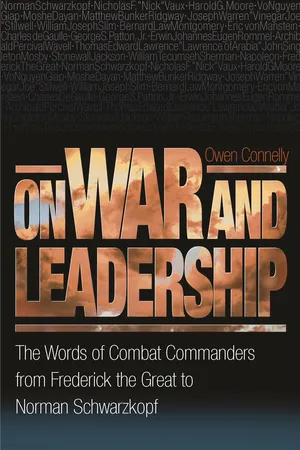
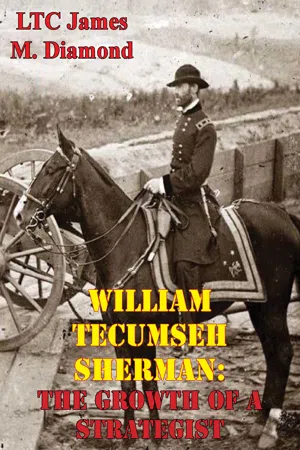

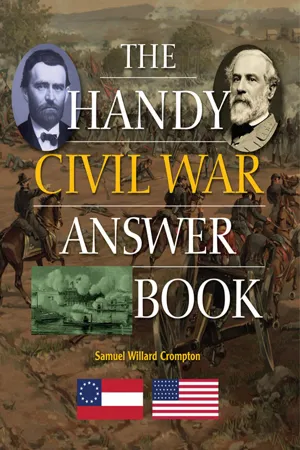
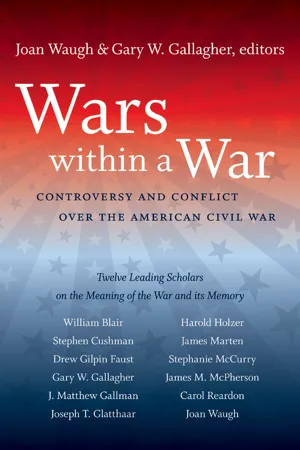
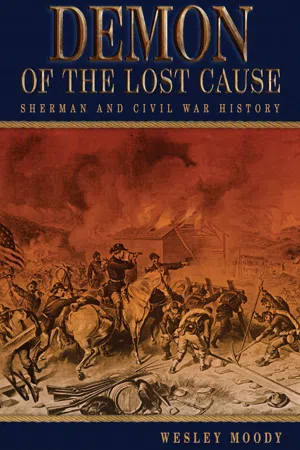
![Forty-Six Years In The Army [Illustrated Edition]](https://img.perlego.com/book-covers/3020251/9781786251350_300_450.webp)
